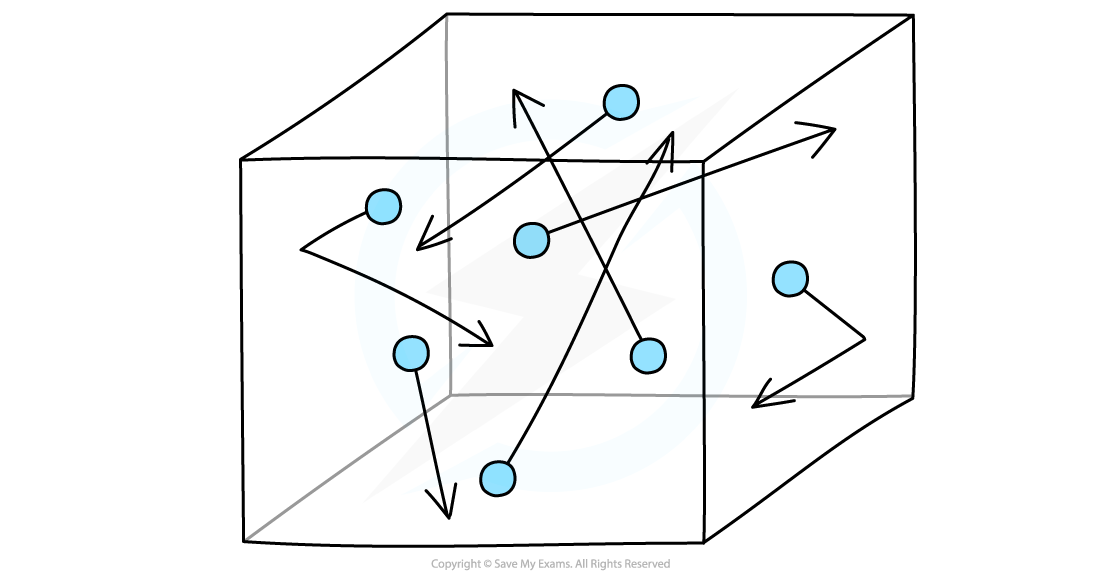Internal Energy (OCR A Level Physics): Revision Note
Exam code: H556
Internal Energy
The energy stored in a substance can be classified into two forms:
kinetic energy
electrostatic potential energy
The kinetic energy stored in the molecules of a substance is:
due to the speed and mass of the molecules
related to the temperature of the substance
The electrostatic potential energy stored in the molecules of a substance is:
due to the separation and forces of attraction (bonds) between the molecules
related to the phase of state of the substance

The amount of kinetic and electrostatic potential energy a substance contains depends on its phase of matter (solid, liquid, or gas)
This is known as internal energy
The internal energy of a substance is defined as:
The sum of the randomly distributed kinetic and potential energies of atoms or molecules within a substance

When a substance is heated, both the kinetic energy and potential energy of the particles increase
The symbol for internal energy is U, with units of Joules (J)
Particles are randomly distributed, meaning they all have different speeds and the separation between each molecule varies
The internal energy of a system is determined by:
Temperature
Higher temperature means greater kinetic energy
Lower temperature means less kinetic energy
The random motion of molecules
The phase of matter: gases have the highest internal energy, solids have the lowest
Intermolecular forces between the particles
Stronger intermolecular forces mean higher potential energy
Weaker intermolecular forces mean lower potential energy
The strength of the intermolecular forces is linked to the phase (solid, liquid, gas) of the substance
The internal energy of a system increases by:
Doing work on it
Adding heat to it
The internal energy of a system decreases by:
Losing heat to its surroundings
Changing phase from a gas to liquid or liquid to solid
Examiner Tips and Tricks
Always remember internal energy is made up of both the kinetic and electrostatic potential energy of the particles in a substance.
Absolute Zero
On the thermodynamic (Kelvin) temperature scale, absolute zero is defined as:
The lowest temperature possible. Equal to 0 K or -273.15 °C
It is not possible to have a temperature lower than 0 K
This means a temperature in Kelvin will never be a negative value
Absolute zero is defined as:
The temperature at which the molecules in a substance have zero kinetic energy
This means that for a system at 0 K, it is not possible to remove any more energy from it
Even in space, the temperature is roughly 2.7 K, just above absolute zero
Internal Energy and Temperature
When a substance is heated, its internal energy (sometimes referred to as thermal energy or heat) increases
As a substance’s internal energy increases, so will its temperature
The higher the temperature of a substance, the more internal energy it possesses

As the temperature of a substance is increased, the total energy of the molecules (the internal energy) increases
Since temperature is a measure of the average kinetic energy of the molecules, only an increase in the average kinetic energy of the molecules will result in an increase in temperature of the substance
Due to thermal expansion, when the temperature of a substance increases, the potential energy of the molecules also increases
Temperature and internal energy are directly proportional to each other
A decrease in temperature will result in a proportional decrease in internal energy
Where:
ΔU = change in internal energy (J)
ΔT = change in temperature (K)
Worked Example
A student suggests that when an ideal gas is heated from 50 oC to 150 oC, the internal energy of the gas is tripled.
State and explain whether the student’s suggestion is correct.
Answer:
Step 1: State the relationship between internal energy and temperature
The internal energy of an ideal gas is directly proportional to its temperature in Kelvin
Step 2: Convert the initial and final temperatures into Kelvin
Step 3: Calculate the ratio between the two temperatures and energies
Since ,
Step 4: State a conclusion
The temperature change, in Kelvin, does not triple
Since ΔU ∝ ΔT, the internal energy also does not triple
Therefore, the student's conclusion is incorrect
Examiner Tips and Tricks
Remember that a change in internal energy does not necessarily correspond to a change in temperature.
A change in the average kinetic energy of the molecules corresponds to a change in temperature
A change in the average electrostatic potential energy of the molecules does not affect temperature
Internal Energy and Phase Change
A phase change is another way of saying a change of state
The states of matter are solid, liquid, and gas
When a substance reaches a certain temperature, the kinetic energy of the molecules will stop increasing, and the heat energy will go into increasing the electrostatic potential energy instead
This breaks the bonds between the molecules, causing them to move further apart and
This leads to a change of phase (e.g. liquid to gas)
When a substance is heated and changes phase (from solid to liquid, or liquid to gas):
electrostatic potential energy increases as bonds are broken, and the separation of the molecules increases
kinetic energy remains the same, hence the temperature remains the same, even though the substance is still being heated
When a substance is cooled and changes phase (from gas to liquid, or liquid to solid):
electrostatic potential energy decreases as bonds are formed, and the separation of the molecules decreases
kinetic energy remains the same, hence the temperature remains the same, even though the substance is still being cooled

An increase in internal energy from heating can cause a change of state
Examiner Tips and Tricks
Remember that whilst a substance changes phase, it does so at a constant temperature.

Unlock more, it's free!
Did this page help you?